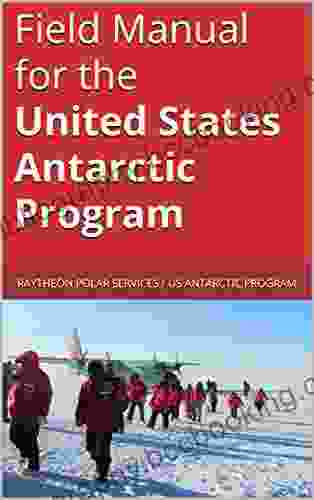Field Manual for the United States Antarctic Program: Your Comprehensive Guide to the Frozen Continent

5 out of 5
| Language | : | English |
| File size | : | 5595 KB |
| Text-to-Speech | : | Enabled |
| Screen Reader | : | Supported |
| Enhanced typesetting | : | Enabled |
| Word Wise | : | Enabled |
| Print length | : | 284 pages |
| Lending | : | Enabled |
Antarctica, the coldest, driest, and highest continent on Earth, is a land of extremes. It is a place of unparalleled beauty and scientific wonder, but it is also a place of danger and hardship. The Field Manual for the United States Antarctic Program is your comprehensive guide to this fascinating continent.
This manual provides everything you need to know about Antarctica, from its history and geography to its climate and wildlife. It also includes essential information on how to prepare for an Antarctic expedition, how to survive in the harsh conditions, and how to protect the fragile environment.
Whether you are a scientist, a polar explorer, or simply an armchair traveler, the Field Manual for the United States Antarctic Program is an indispensable resource. With this book in hand, you will be well-prepared to experience the wonders of Antarctica safely and responsibly.
Table of Contents
- Chapter 1: to Antarctica
- Chapter 2: History of Antarctic Exploration
- Chapter 3: Geography of Antarctica
- Chapter 4: Climate of Antarctica
- Chapter 5: Wildlife of Antarctica
- Chapter 6: Logistics of Antarctic Expeditions
- Chapter 7: Survival in Antarctica
- Chapter 8: Environmental Protection in Antarctica
- Chapter 9: Appendix
Chapter 1: to Antarctica
Antarctica is the fifth largest continent on Earth, and it is the only continent that is entirely covered in ice. It is also the coldest, driest, and highest continent on Earth.
Antarctica is located at the South Pole, and it is surrounded by the Southern Ocean. The continent is about 14 million square kilometers in size, and it has a population of about 1,000 people.
Antarctica is a place of unparalleled beauty and scientific wonder. It is home to some of the most unique and fragile ecosystems on Earth.
Chapter 2: History of Antarctic Exploration
The first Europeans to sight Antarctica were the Spanish explorers Gabriel de Castilla and Juan Sebastian de Elcano in 1520. However, it was not until the 19th century that Antarctica was truly explored.
In 1820, the Russian explorer Fabian Gottlieb von Bellingshausen and the British explorer Edward Bransfield both sighted the Antarctic continent.
In 1840, the United States Exploring Expedition led by Charles Wilkes became the first expedition to explore the Antarctic coastline.
In 1899, the British explorer Ernest Shackleton led the first expedition to overwinter on the Antarctic continent.
In 1911, the Norwegian explorer Roald Amundsen became the first person to reach the South Pole.
Chapter 3: Geography of Antarctica
Antarctica is a continent of extremes. It is the coldest, driest, and highest continent on Earth.
Antarctica is covered in ice, and the average temperature is -57 degrees Celsius. The continent is also very dry, with an average annual precipitation of only 200 millimeters.
Antarctica is the highest continent on Earth, with an average elevation of 2,300 meters.
Antarctica is divided into two main regions: East Antarctica and West Antarctica.
East Antarctica is the larger of the two regions, and it is home to the South Pole.
West Antarctica is the smaller of the two regions, and it is home to the Antarctic Peninsula.
Chapter 4: Climate of Antarctica
The climate of Antarctica is very cold and dry.
The average temperature in Antarctica is -57 degrees Celsius.
The coldest place on Earth is the Vostok Station in East Antarctica, where the temperature has dropped to -89.2 degrees Celsius.
Antarctica is also very dry, with an average annual precipitation of only 200 millimeters.
The winds in Antarctica are very strong, and they can reach speeds of up to 300 kilometers per hour.
Chapter 5: Wildlife of Antarctica
Antarctica is home to a unique and fragile ecosystem.
The most iconic animal in Antarctica is the penguin.
There are 17 species of penguins in Antarctica, including the emperor penguin, the king penguin, and the gentoo penguin.
Other animals that live in Antarctica include seals, whales, and seabirds.
The Antarctic ecosystem is very delicate, and it is important to protect it from human activity.
Chapter 6: Logistics of Antarctic Expeditions
Planning an Antarctic expedition requires careful planning and logistics.
The first step is to obtain a permit from the National Science Foundation.
Once you have obtained a permit, you will need to plan your itinerary and budget.
You will also need to pack appropriate clothing and equipment for the harsh Antarctic conditions.
It is important to remember that Antarctica is a dangerous place, and you should always take precautions to stay safe.
Chapter 7: Survival in Antarctica
Survival in Antarctica requires careful planning and preparation.
The first step is to learn how to protect yourself from the cold.
You should also learn how to build a shelter and how to find food and water.
It is important to remember that Antarctica is a very dangerous place, and you should always take precautions to stay safe.
Chapter 8: Environmental Protection in Antarctica
Antarctica is a pristine environment, and it is important to protect it from human activity.
The Antarctic Treaty System is an international agreement that protects Antarctica from mining, drilling, and other harmful activities.
It is important to follow the rules and regulations of the Antarctic Treaty System to protect the environment.
Chapter 9: Appendix
The appendix contains a variety of useful information, including:
- A list of Antarctic research stations
- A glossary of Antarctic terms
- A bibliography of Antarctic literature
- A list of Antarctic websites
The Field Manual for the United States Antarctic Program is an indispensable resource for anyone who is planning an Antarctic expedition.
This manual provides everything you need to know about Antarctica, from its history and geography to its climate and wildlife.
With this book in hand, you will be well-prepared to experience the wonders of Antarctica safely and responsibly.
Free Download your copy today!
5 out of 5
| Language | : | English |
| File size | : | 5595 KB |
| Text-to-Speech | : | Enabled |
| Screen Reader | : | Supported |
| Enhanced typesetting | : | Enabled |
| Word Wise | : | Enabled |
| Print length | : | 284 pages |
| Lending | : | Enabled |
Do you want to contribute by writing guest posts on this blog?
Please contact us and send us a resume of previous articles that you have written.
 Book
Book Novel
Novel Page
Page Chapter
Chapter Text
Text Story
Story Genre
Genre Reader
Reader Library
Library Paperback
Paperback E-book
E-book Magazine
Magazine Newspaper
Newspaper Paragraph
Paragraph Sentence
Sentence Bookmark
Bookmark Shelf
Shelf Glossary
Glossary Bibliography
Bibliography Foreword
Foreword Preface
Preface Synopsis
Synopsis Annotation
Annotation Footnote
Footnote Manuscript
Manuscript Scroll
Scroll Codex
Codex Tome
Tome Bestseller
Bestseller Classics
Classics Library card
Library card Narrative
Narrative Biography
Biography Autobiography
Autobiography Memoir
Memoir Reference
Reference Encyclopedia
Encyclopedia Ira J Chasnoff
Ira J Chasnoff Mercades Lias
Mercades Lias Ingrid Sawubona
Ingrid Sawubona Molly Absolon
Molly Absolon Isabelle Hamptonstone Msc
Isabelle Hamptonstone Msc Kai M Jordan
Kai M Jordan Marcelo Gleiser
Marcelo Gleiser Isabelle Arsenault
Isabelle Arsenault Mike P Mckeever
Mike P Mckeever John Brierley
John Brierley Vanja Hamzic
Vanja Hamzic Pierre Schlag
Pierre Schlag Peter Forbes
Peter Forbes Jessica Dunham
Jessica Dunham Jack Disbrow Gunther
Jack Disbrow Gunther Ian Morris
Ian Morris Christina C Jones
Christina C Jones Matt Vincent
Matt Vincent Laurieann Gibson
Laurieann Gibson Victoria Payne
Victoria Payne
Light bulbAdvertise smarter! Our strategic ad space ensures maximum exposure. Reserve your spot today!

 Henry David ThoreauJourney to the Heart of Iraq: A Memoir of Education, Adventure, and...
Henry David ThoreauJourney to the Heart of Iraq: A Memoir of Education, Adventure, and...
 Dylan MitchellUnlock Your Golfing Potential: The Golf Swing Simple Secret Revolutionary...
Dylan MitchellUnlock Your Golfing Potential: The Golf Swing Simple Secret Revolutionary... Neil GaimanFollow ·11.3k
Neil GaimanFollow ·11.3k Christopher WoodsFollow ·6.3k
Christopher WoodsFollow ·6.3k Fernando BellFollow ·14k
Fernando BellFollow ·14k Ian MitchellFollow ·3.9k
Ian MitchellFollow ·3.9k Christian BarnesFollow ·11.9k
Christian BarnesFollow ·11.9k Isaiah PriceFollow ·10.3k
Isaiah PriceFollow ·10.3k Ricky BellFollow ·19.2k
Ricky BellFollow ·19.2k Damon HayesFollow ·14.8k
Damon HayesFollow ·14.8k

 Luke Blair
Luke Blair101 Amazing Facts About Australia: A Journey Through the...
A Literary Expedition Unveiling the Treasures...

 Harry Hayes
Harry HayesWitness the Velocity and Legacy of the Scarlet Speedster:...
Delve into the Lightning-Charged...

 Stan Ward
Stan Ward101 Amazing Facts About Ancient Egypt: Unraveling the...
: A Timeless Realm of Wonder Ancient Egypt, a...

 Stephen King
Stephen KingEscape into Adventure: Unveil the Secrets of Adventure...
In the annals of comic book history,...

 Forrest Blair
Forrest BlairThe Oxford Dog Training Company Presents: A Holistic...
In the realm of dog...
5 out of 5
| Language | : | English |
| File size | : | 5595 KB |
| Text-to-Speech | : | Enabled |
| Screen Reader | : | Supported |
| Enhanced typesetting | : | Enabled |
| Word Wise | : | Enabled |
| Print length | : | 284 pages |
| Lending | : | Enabled |










